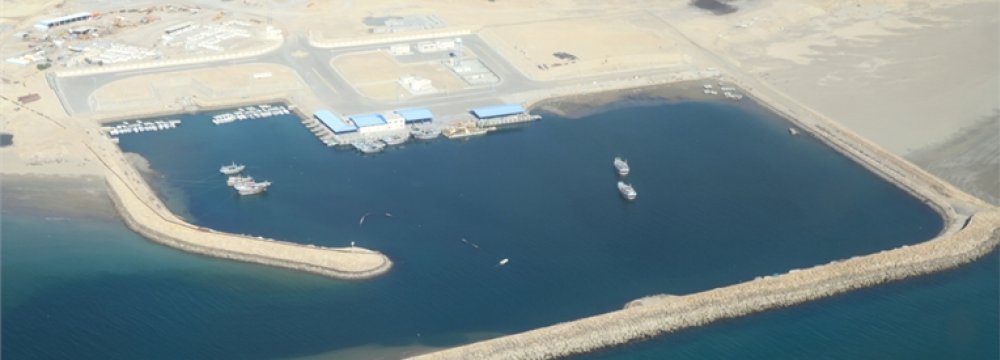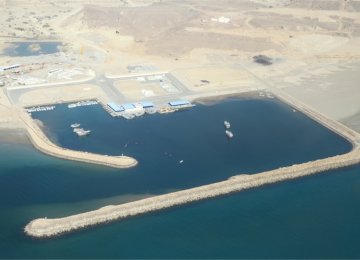Work on the development of the southeastern port and special economic zone of Chabahar in Sistan-Baluchestan Province is making rapid progress.
"Iran has received a $235 million credit line from the $500 million India had earlier agreed to provide for the port's development," Minister of Roads and Urban Development Abbas Akhoundi said.
Akhoundi was speaking on the sidelines of a meeting with Indian Transport Minister Nitin Gadkari and his Afghan counterpart, Mohammadullah Batash, in New Delhi on Wednesday, IRNA reported.
Heading a delegation of senior officials, including CEO of Ports and Maritime Organization, Mohammad Saeednejad, Akhoundi arrived in India on Wednesday for a visit to discuss connectivity projects with Indian officials.
Tehran, New Delhi and Kabul signed an ambitious trilateral agreement to develop Chabahar in Tehran in May, when Indian Prime Minister Narendra Modi and Afghan President Ashraf Ghani came for a visit.
The deal envisages development and operation for 10 years of two terminals and three berths at the port with cargo handling capacities.
Based on the agreement, Iran will provide land in the Chabahar SEZ for Indian companies to set up petrochemical, fertilizer and other gas-based industries by Indian companies.
India has also agreed to construct a 500-km railroad from Chabahar to Zahedan, Sistan-Baluchestan’s capital which is close to the Afghan border. India’s state-owned IRCON has agreed to build a rail route at a cost of $1.6 billion as part of the transit corridor to Afghanistan.
IRCON’s MoU with Construction, Development of Transport and Infrastructure Company of Iran for building the line was among the dozen agreements signed when Modi visited Tehran.
The agreement was signed by IRCON Managing Director Mohan Tiwari and President of the Islamic Republic of Iran Railways Mohsen Pourseyyed-Aqaei, in the presence of President Hassan Rouhani and the Indian premier.
After connecting Chabahar to Zahedan, the railroad will be linked to Zaranj in Afghanistan. Hence, when the Afghan cargo arrives in Zahedan, it can be transported by a 1,380-km railroad to Chabahar and then shipped to India.
A major economic summit will be held in India or Afghanistan within the next two months to attract investment from across the globe for the strategic port.
“We are going to address some of the technical issues involved in the Chabahar agreement and within the next two months we will—in India or Iran, but more likely India—call a major economic summit where all the industries will participate from India, Afghanistan, Iran and from beyond,” Afghan Ambassador to India Shaida Abdali was quoted as saying by Financial Express.
>Multimodal Trade Path
According to an Indian media report, during the recent visit, Iran also sought New Delhi’s help to develop an international airport in Chabahar.
“Chabahar already has an operational airport. The Iranian minister asked us whether India would be willing to develop and modernize it,” Mumbai-based daily Economic Times quoted a senior Indian official, who did not wish to be identified, as saying on the sidelines of the Wednesday meeting.
According to Mohammad Hossein Malekzadegan, a board member of Chabahar Free Zone Organization, the airport has been designed and the relevant permits have been issued.
In the next step, the organization will tender projects for the construction of different sections of the airport, including runway, apron, terminals and control tower, which are expected to be completed in 18 months.
Also on Thursday, the Iranian mission visited the largest container port of India, Jawaharlal Nehru Port in Mumbai, which is to be connected to Chabahar as part of a grand world trade route: the International North-South Transport Corridor.
The INSTC, which is a multimodal cargo route, is to connect India to Central Asia and Russia through Iran. It will serve as a safe path for shipment of cargo from India to Europe, bypassing Pakistan.
If completed, the path is expected to lift Iran-India trade significantly.
According to Islamic Republic of Iran Customs Administration, Iran exported $2.5 billion worth of non-oil goods to India in the last Iranian year. Exports almost remained unchanged compared to the previous year. Last year’s imports from the country stood at $2.3 billion, registering a 40% drop over the preceding year.
The latest trade data show that Iran exported over 3 million tons of non-oil goods, valued at $1.1 billion to India during the first four months of the current Iranian year (started March 20), posting a 21% increase over the similar period of the previous year. Gas condensates, petrochemicals, steel products, gypsum, dates and pistachios were among the main exports.
Meanwhile, 497,000 tons of goods worth $523.7 million were imported from India during the period, which indicates a 38% decline compared with the year before. Main imports included rice, steel products, iron ore, aluminum oxide, industrial machinery, pharmaceuticals, tea, bananas, papers and wood.






Add new comment
Read our comment policy before posting your viewpoints